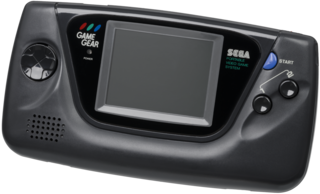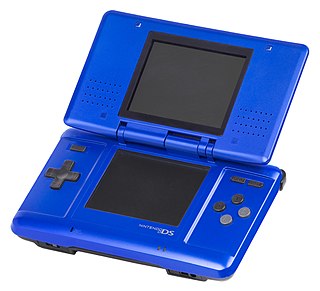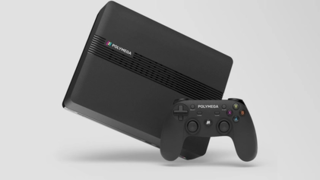
The Game Boy Advance (GBA) is a 32-bit handheld game console developed, manufactured and marketed by Nintendo as the successor to the Game Boy Color. It was released in Japan on March 21, 2001, in North America on June 11, 2001, in the PAL region on June 22, 2001, and in mainland China as iQue Game Boy Advance on June 8, 2004.

The Game.com is a fifth-generation handheld game console released by Tiger Electronics on September 12, 1997. A smaller version, the Game.com Pocket Pro, was released in mid-1999. The first version of the Game.com can be connected to a 14.4 kbit/s modem for Internet connectivity, hence its name referencing the top level domain .com. It was the first video game console to include a touchscreen and the first handheld console to include Internet connectivity.

A handheld game console, or simply handheld console, is a small, portable self-contained video game console with a built-in screen, game controls and speakers. Handheld game consoles are smaller than home video game consoles and contain the console, screen, speakers, and controls in one unit, allowing players to carry them and play them at any time or place.

The Game Gear is an 8-bit fourth generation handheld game console released by Sega on October 6, 1990, in Japan, in April 1991 throughout North America and Europe, and during 1992 in Australia. The Game Gear primarily competed with Nintendo's Game Boy, the Atari Lynx, and NEC's TurboExpress. It shares much of its hardware with the Master System, and can play Master System games through the use of an adapter. Sega positioned the Game Gear, which had a full-color backlit screen with a landscape format, as a technologically superior handheld to the Game Boy.

The Nintendo DS is a foldable handheld game console produced by Nintendo, released globally across 2004 and 2005. The DS, an initialism for "Developers' System" or "Dual Screen", introduced distinctive new features to handheld games: two LCD screens working in tandem, a built-in microphone and support for wireless connectivity. Both screens are encompassed within a clamshell design similar to the Game Boy Advance SP. The Nintendo DS also features the ability for multiple DS consoles to directly interact with each other over Wi-Fi within a short range without the need to connect to an existing wireless network. Alternatively, they could interact online using the now-defunct Nintendo Wi-Fi Connection service. Its main competitor was Sony's PlayStation Portable during the seventh generation of video game consoles.

The Dingoo is a handheld gaming console that supports music and video playback and open game development. The system features an on-board radio and recording program. It was sold to consumers in three colors: white, black, and pink. It was released in February 2009 and had sold over 1 million units.

The Wii U GamePad is the standard game controller for Nintendo's Wii U home video game console. Incorporating features from tablet computers, the GamePad has traditional input methods, touchscreen controls, and motion controls. The touchscreen can be used to supplement a game by providing alternate, second screen functionality or an asymmetric view of a scenario in a game. The screen can also be used to play a game strictly on the GamePad screen without the use of a television display. Conversely, non-gaming functions can be assigned to it as well, such as using it as a television remote.

The Neo Geo X (NGX) is a hybrid video game console manufactured by Tommo, licensed by SNK Playmore. Information about the Neo Geo X was first reported in January 2012 and later confirmed in March. It is the first Neo Geo system to be released since the discontinuation of the brand in 2004 and the third Neo Geo handheld console, following the 1999 release of the Neo Geo Pocket Color, which was supported until 2001.

The Nintendo 2DS is a handheld game console produced by Nintendo. Announced in August 2013, the device was released in North America, Europe and Australia on October 12, 2013. The Nintendo 2DS is an entry-level version of the Nintendo 3DS which maintains otherwise identical hardware, similar functionality, and compatibility with software designed for the Nintendo DS and 3DS. However, the 2DS is differentiated by a new slate form factor rather than the clamshell design used by its precursors and by lacking the Nintendo 3DS's signature autostereoscopic 3D display. The 2DS was sold concurrently with existing 3DS models as an incentive to expand the market for Nintendo 3DS games; former Nintendo of America president Reggie Fils-Aimé stated that the 2DS was primarily targeted towards younger players, whom Nintendo had previously advised not to use the 3D functionality on the 3DS due to potential eye health concerns. The Nintendo 2DS's successor, the New Nintendo 2DS XL, was launched in 2017.

Hyperkin is an American video game peripheral manufacturer and distributor, founded in 2006, based in Los Angeles, California. They distribute accessories for major gaming consoles, in addition to creating clone consoles that play retro games with modern resolutions and on modern devices, most notably the RetroN series of clone consoles. As with most other NES clones, Hyperkin's NES clones suffer from imperfect sound due to a design flaw in the sound hardware.

The Analogue Pocket is a handheld game console designed and manufactured by Analogue. Announced in October 2019 and released on December 13, 2021, it uses field-programmable gate array (FPGA) chips to play games from various handheld consoles up to the sixth generation.

The Evercade is a handheld game console developed and manufactured by UK company Blaze Entertainment. It focuses on retrogaming with ROM cartridges that each contain a number of emulated games. Development began in 2018, and the console was released in May 2020, after a few delays. Upon its launch, the console offered 10 game cartridges with a combined total of 122 games.

Game & Watch: Super Mario Bros. is a limited-edition Game & Watch system developed and published by Nintendo, released on November 13, 2020. The system features three Nintendo games: Super Mario Bros. (1985), Super Mario Bros.: The Lost Levels (1986), and a Mario-themed version of Ball (1980). The system was released for the 35th anniversary of the Super Mario series and the 40th anniversary of the Game & Watch line.

Evercade VS is a video game console developed by UK company Blaze Entertainment. It is an upgraded home console version of the original Evercade handheld that introduces multiplayer functionality. It was released in December 2021 in Europe, and on 25 February 2022 in the United States.

The Steam Deck is a handheld gaming computer developed by Valve and released on February 25, 2022. The device uses Valve's Linux distribution SteamOS, which incorporates the namesake Steam storefront. SteamOS uses Valve's Proton compatibility layer, allowing users to run Windows applications and games. In addition to handheld use, the Steam Deck can be connected to a TV or monitor through a docking station and be used like a desktop computer or home video game console. In desktop mode, users can install third-party applications for Linux.
The Anbernic RG351 is a Linux-based handheld game console created in China by Anbernic. The console uses a microSD card for storage and is a digital ROM-only console. It is the successor to the RG350, and has emerged as a prominent handheld console for retrogaming alongside the Retroid Pocket 2, with the screen aspect ratio of some models particularly optimized for Game Boy Advance titles. It is sold in several models with different shells and screen resolutions, but similar internal specifications. Critics have praised its quality and functionality, but criticized certain aspects of its design.
The Retroid Pocket 2 is an Android-based handheld video game console created in China by GoRetroid and released in September 2020. An emulation console, it is capable of playing games from various handheld and non-handheld systems, including all consoles up to the Dreamcast. As the device does not accept game cartridges or discs, the user must supply a ROM image of the games they wish to play. It is the successor to the Retroid Pocket, and has emerged as a prominent handheld console for retrogaming alongside the Anbernic RG351. It is priced at US$84.99, however, a second version, the Retroid Pocket 2+, was released in early 2022, featuring a touchscreen, stronger CPU and RAM, and higher-quality buttons, at a slightly higher price point of US$99. A third version, the Retroid Pocket 2S, was released in mid 2023, featuring even stronger CPU and RAM. Critics praised its low price and build quality, but its outdated Android version, front end interface, low battery life, and offset analog sticks were noted as points of contention.

Polymega is a home video game console developed by American company Playmaji, Inc. It is a retro gaming console offering backwards compatibility with several CD-based and cartridge-based platforms: PlayStation, TurboGrafx-CD, Neo Geo CD, Sega CD, Sega Saturn, Nintendo Entertainment System (NES), Sega Genesis, Sega 32X, Super Nintendo Entertainment System (SNES), and Nintendo 64. It includes a built-in CD drive, while separate add-ons known as Element Modules provide support for cartridge-based games.
The Ayn Odin is an Android-based handheld video game console created in China by the company Ayn. A retrogaming emulation and mobile gaming console, it is slightly smaller than the Nintendo Switch. It was released in three models of increasing price, the Lite, Base, and Pro. The product of a successful Indiegogo campaign, it was critically praised at the time of release as one of the most powerful handheld consoles for the price, able to reliably play games from the sixth generation of home consoles. A successor, named the Ayn Odin 2 was released in fall 2023.
Anbernic is a Chinese manufacturer of handheld retrocomputing devices based in Shenzhen. Typically running a version of Android or Linux, these allow users to play historical video games through software emulation.















